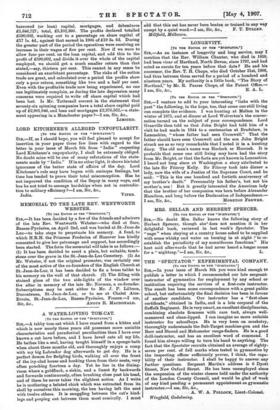COTTON TRADE PROFITS.
[To Tn. EDITOR OF Till `SPECTATOR:] Srit,—I have been wondering what can be the real meaning and object of publishing the results of Lancashire cotton- spinning companies so broadcast, and booming the profits as showing such a large percentage when calculated on share capital or share and loan capital.. It is certain they must have a mischievous effect. We must not forget that Mr. William Tattersall is the late secretary of the Federation of Master Cotton Spinners' Associations, and this fact alone, coupled with the statement that the profits recently announced by spinning companies " work out at 3044 per cent. per annum" (Spectator, April 27th), must carry weight with the workers in the cotton-spinning mills. We can see that the publication of such spasmodic figures must have an effect on the minds of these workers, who will press the officials of their Trade-Unions. We know that the officials of these societies are regulated in their applications for wages advances by the margin between the price paid for cotton and what is received for yarn. But we can easily see that these officials will, with such statements put forward as those referred to, be pressed to make an application for advance sooner than circumstances on the day warrant it, for we must not forget that the profits now announced are on the orders booked three to six months ago, and may be longer back than that. I do not say that the figures put forward by Mr. Tattersall are incorrect, neither do I say that the present state of the spinners margin does not warrant the present application for a five per cent. increase in wages. My grievance is that the figures are misleading in the sense that, covering only a half or a quarter of a year, they are not to be regarded as a criterion of what a year's balancing will bring forth. In proof of this contention let me quote figures published on December 22nd last by the Oldham Standard, the compiler of which is a well-known authority on such matters. The figures relate to the returns of ninety cotton-spinning companies distributed in the districts of Oldham, Ashton-under-Lyne, Rochdale, and Bury. The share capital of the ninety companies is £3,455,633, and the borrowed (or loan) capital, mortgages, and debentures £1,646,727; total, £5,102,360. The profits declared totalled £590,002, working out to a percentage on share capital of £17 ls. 4d., against that earned in 1905 of 219 3s. 6d. During the greater part of the period the operatives were receiving an increase in their wages of five per cent. Now if we were to allow four per cent. on the loan capital, and add this to the profit of £590,002, and divide it over the whole of the capital employed, we should get a much smaller return than that stated,—say, thirteen per cent. This cannot in any sense be considered an exorbitant percentage. The risks of the cotton trade are great, and calculated over a period the profits show only a poor return, something like two and a half per cent. Even with the profitable trade now being experienced, no one can legitimately complain, as during the late depression many concerns were required to write off share capital which had been lost. Is Mr. Tattersall correct in the statement that seventy-six spinning companies have a total share capital paid up of £2,901,946, and loan and mortgages £2,376,562,—a state- ment appearing in a Manchester paper P—I am, Sir, &c.,
LIMITED.















































 Previous page
Previous page